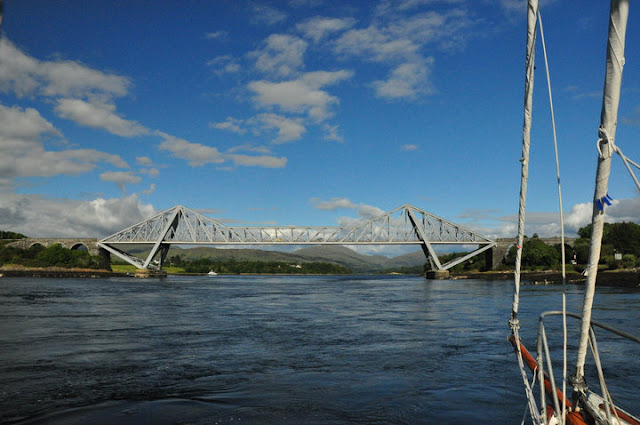The seventh day of the voyage dawned bright and sunny, with the sea like a mirror under the pale blue, cloudless sky. A final trip ashore for some more beer and we were off, aiming to reach the Connel Bridge at 12.30pm to allow us through at slack water. We motored out of Oban bay and past Dunollie Castle on the headland, staying on the outside of Maiden Island so as to avoid some submerged rocks. The passage to Loch Etive was uneventful, save for the relentless chugging of the donkey over the flat calm waters of the Firth of Lorn. We soon passed Dunstaffnage Marina at the entrance to the Loch, and picked up a mooring off the Connel Hotel to assess the situation under the bridge.
Now, dear reader, it would bear explanation here that the waters under the Connel bridge, known as the 'Falls of Lora', are among the most dangerous and violent anywhere in the world. The bridge itself has a maximum clearance of 14m charted, and with our air draft of 13.8m we decided to wait the afternoon out for low tide. Hitting the bridge was not a risk the skipper was about to take. Having arrived at the mooring at slack water, we were astounded that a mere 30 minutes later the sea under the bridge was a mass of white water the likes of which one only sees in rivers, whilst the water all around boiled and eddied with whirpools and eerie patches of calm. Watching leaves floating past the boat at great speed showed just how vicious the tide was here (8 knots, or faster than the Good Ship can ever travel). The reason for this phenomenon is the combination of the constriction of water under the bridge and a ledge under water which holds the sea up on one side 1.4 metres higher than the other as the tide flows past, meaning that the water actually FALLS over the ledge in the only salt water waterfall in the world. They are as veritable cauldron of white water for the majority of the tide, and far too dangerous to taverse until slack water. The usual traveller crossing the bridge would probably never notice the wonder going on beneath him, transfixed as most are by the view beyond the end of the bridge. But make no mistake, the Falls of Lora are indeed spectacular, and mystical in their ways. We were later told that local canoeists like to canoe into the largest of the whirlpools by the bridge, get sucked down to the bottom of the sea, from where they get shot along the seabed by the 8 knot tides before emerging 50 yards past the other side of the bridge. A neat party trick, I'd say.
We waited in awe at the spectacle of the Falls until the water suddenly went flat, and the torrents were replaced by a mysterious swirling and eddying. At this, we dropped the mooring and headed towards the bridge, aiming to line ourselves up with the small sub-strut between the first and second diagonal main struts off the starboard end of the bridge. 10 yards to the left, you hit the ledge. 10 to the right, you are on the rocks. No margin for error. It was no wonder that we later leaned that they see very few yachts up Loch Etive nowadays.
As we approached the bridge, the swirling eddies tried to turn us this way and that, and at the crucial moment the boat suddenly lurched hard towards the first of the Bridge's piers. Full throttle had us inching forwards at 1 knot whilst 5 knots of current tried to sweep us onto the rocks. The crew noted that they thought the masthead was about to hit the bridge above, but the skipper was too preoccupied trying to avoid foundering. The Good Ship finally wrestled herself free, with the skipper thanking the donkey before lining up the next set of transits to avoid yet more rocks. But the splendour of Glen Etive was opning out before us, and it was rapidly becoming clear why the authors Neil Gunn and Mairi Hedderwick had both proclaimed Loch Etive to be the finest of all Scottish Sea Lochs.
The loch winds it's way 20 miles into Lorn, with the narrows at the midpoint flanked by the majesty of Ben Cruachan and the beauty of Glencoe opening out beyond the head of the loch. It is little more than a mile wide, and very sparsely populated, with only a few very pretty houses and the odd castle along it's shores. We had a glorious sail up the loch in a light evening breeze, past the ruin of Archattan Priory where Robert the Bruce is said to have held the last Paliament in which the Gaelic language was used. Every turn in the loch's winding path offered stunning new vistas, and very few signs of civilisation until we reached our destination for the night, the old Iron working village of Bonawe. We were able to pick up a mooring, which was just as well given the plunging depths of the loch at this point, and after a quick sojourn ashore (where we learned from a local couple that very few boats ever came up the loch nowadays) we settled down under the light of the oil lamps to a well deserved supper. What a perfect day.



No comments:
Post a Comment